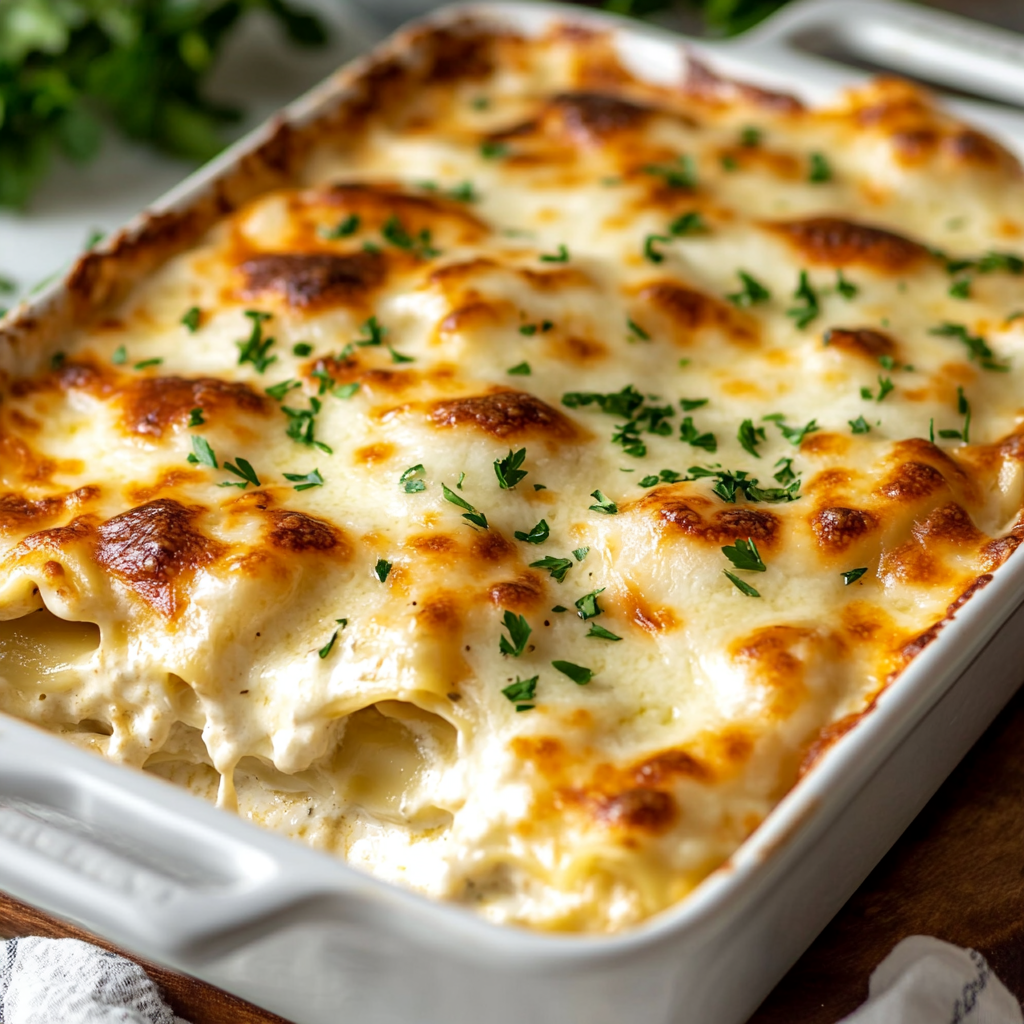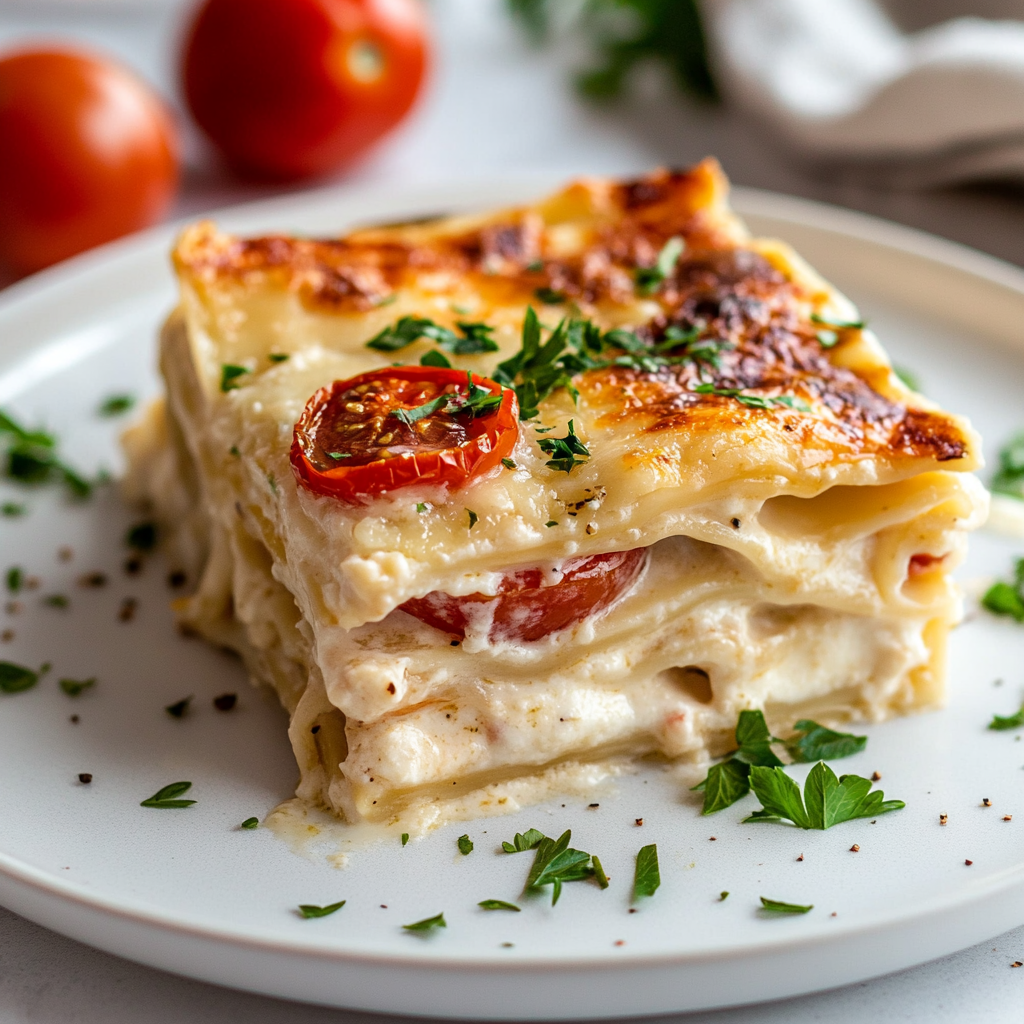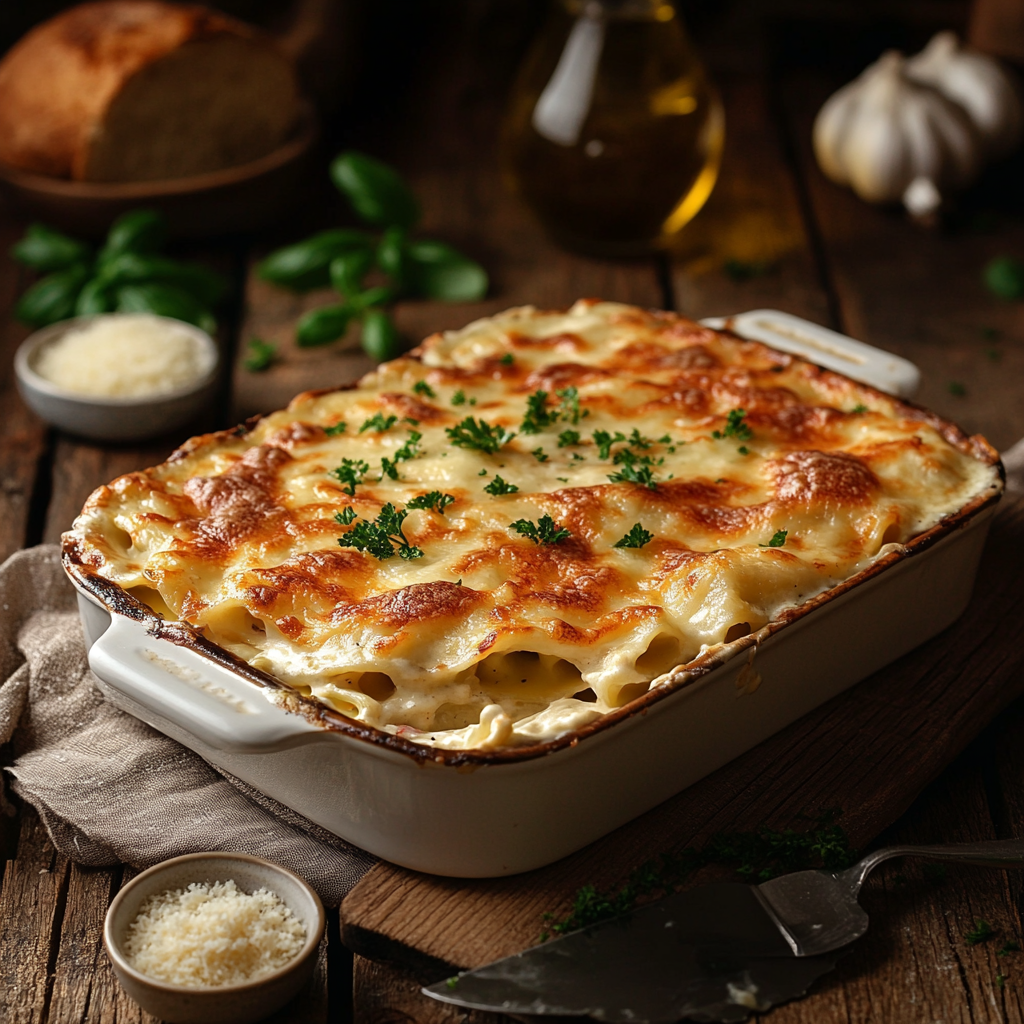Alfredo Lasagna: The Ultimate Guide to a Creamy Italian Delight
Alfredo Lasagna is more than just a dish—it’s a creamy, cheesy embrace on a plate. This unique combination of rich Alfredo sauce layered with pasta sheets has captured hearts around the globe. In this article, we’ll dive deep into its origins, ingredients, preparation techniques, and even variations that cater to every dietary preference. Whether you’re a seasoned chef or a beginner looking to impress, this guide has you covered.
Introduction to Alfredo Lasagna
1.1 What is Alfredo Lasagna?
Imagine the comforting layers of traditional lasagna, but instead of the tomato-based sauce, you have the smooth, velvety Alfredo sauce that wraps every bite in creamy goodness. That’s what Alfredo Lasagna is—a fusion of Italian comfort food classics.
This dish marries the indulgence of cheesy Alfredo pasta with the structure of lasagna, creating a recipe that feels luxurious but is surprisingly easy to make. Its appeal lies in its versatility—you can add proteins like chicken or shrimp, load it up with vegetables, or keep it vegetarian with spinach and mushrooms. It’s the perfect choice for weeknight dinners, family gatherings, or special occasions where you want to make a statement with your cooking.
1.2 History of Alfredo Sauce
The roots of Alfredo sauce date back to early 20th-century Rome. This iconic white sauce was created by Alfredo di Lelio, an Italian chef, who originally crafted it to help his wife regain her appetite after childbirth. Made from a simple combination of butter, Parmesan cheese, and pasta water, it was both comforting and nourishing.
However, as the recipe crossed borders, chefs worldwide started putting their spin on it. Cream became a common addition, enhancing its richness. Today, it’s a staple in Italian-American cuisine and the foundation of many beloved dishes, including creamy Alfredo Lasagna.
1.3 Evolution of Lasagna Dishes
Traditional lasagna has long been a symbol of Italian cuisine, typically made with layers of pasta, meat sauce, ricotta, and mozzarella. However, food is never static; it evolves with creativity and cultural influences. Enter Alfredo Lasagna—a delightful twist that swaps out the classic tomato-based sauce for creamy Alfredo.
This version offers a milder, creamier flavor profile that balances the pasta’s texture beautifully. With the rise of culinary experimentation, Alfredo Lasagna has found its place on tables worldwide, becoming a favorite for those who prefer a lighter yet equally indulgent alternative to the classic.
If you love the comforting layers of traditional lasagna, you might also enjoy baked ziti, another Italian classic that’s perfect for cozy dinners
Ingredients and Preparation
2.1 Essential Components of Alfredo Lasagna
Creating a delicious Alfredo Lasagna starts with gathering the right ingredients. At its core, this dish requires a few essentials:
- Pasta Sheets: Fresh lasagna sheets work wonderfully for a tender texture, but dried or no-boil sheets are also great options.
- Alfredo Sauce: A creamy white sauce made from butter, cream, and Parmesan cheese.
- Cheeses: Mozzarella, Parmesan, and ricotta (or cottage cheese) add flavor and structure.
- Proteins: Chicken, seafood, or plant-based alternatives bring variety and heartiness to the dish.
Each of these components plays a role in achieving the perfect balance of creaminess, texture, and flavor. Don’t skimp on the quality—it makes a world of difference!
2.2 Selecting Quality Ingredients
The secret to any exceptional dish lies in the quality of its ingredients, and Alfredo Lasagna is no exception.
- Pasta Sheets: Choose fresh or premium dried lasagna sheets with a smooth texture. Gluten-free options are widely available for those with dietary needs.
- Cheeses: Go for freshly grated Parmesan and mozzarella; pre-shredded options often contain anti-caking agents that affect melting. Ricotta should be creamy and smooth.
- Cream and Butter: Use full-fat cream and unsalted butter for the Alfredo sauce to achieve richness without being overly heavy.
- Fresh Produce: Opt for vibrant, unblemished vegetables like spinach and mushrooms for added freshness.
Investing in top-notch ingredients elevates your lasagna from ordinary to extraordinary, ensuring each bite is packed with flavor.
2.3 Preparing Homemade Alfredo Sauce
A rich and creamy Alfredo sauce is the heart of this dish. Here’s how to make it step by step:
Ingredients:
- 2 tablespoons unsalted butter
- 1 cup heavy cream
- 1 cup freshly grated Parmesan cheese
- 1 clove garlic, minced (optional)
Instructions:
- In a saucepan, melt the butter over low heat, being careful not to brown it.
- Add the minced garlic (if using) and sauté briefly until fragrant.
- Pour in the heavy cream and heat gently, stirring continuously to avoid scorching.
- Gradually whisk in the Parmesan cheese, allowing it to melt completely into a velvety sauce.
Tips:
- Don’t let the sauce boil—it can curdle.
- Stir constantly for a smooth, lump-free consistency.
- Adjust thickness by adding a splash of milk or extra Parmesan.
Homemade Alfredo sauce brings a fresh, authentic flavor to your lasagna, setting it apart from store-bought varieties.
2.4 Choosing the Right Pasta for Lasagna
The pasta is the backbone of your Alfredo Lasagna, so selecting the right one is crucial.
- Fresh vs. Dried: Fresh pasta sheets yield a soft, delicate texture but require refrigeration. Dried sheets are convenient and store well.
- No-Boil Options: These are pre-cooked and save time, but they need ample sauce to prevent dryness.
- Gluten-Free Alternatives: Rice-based or lentil-based lasagna sheets are excellent for gluten-free diets and blend well with Alfredo sauce.
Make sure the pasta sheets are evenly cut to fit your baking dish for a uniform presentation.
2.5 Incorporating Proteins: Chicken, Seafood, and Vegetarian Options
Adding proteins can transform Alfredo Lasagna into a hearty main course.
- Chicken: Grilled or shredded chicken pairs beautifully with the creamy sauce. Season lightly with garlic and herbs to enhance the flavor.
- Seafood: Shrimp, crab, or even scallops can lend a luxurious twist. Sauté them briefly to retain their tenderness.
- Vegetarian: For a meat-free version, consider plant-based proteins like tofu or tempeh. Season them well to complement the rich sauce.
When preparing proteins, ensure they’re pre-cooked before layering to maintain the lasagna’s texture and consistency.
2.6 Adding Vegetables for Enhanced Flavor and Nutrition
Vegetables not only add a burst of color but also elevate the flavor of Alfredo Lasagna.
- Spinach: Fresh or frozen, it adds a touch of earthiness. Ensure it’s well-drained to avoid excess moisture.
- Mushrooms: Sautéed mushrooms contribute umami depth and pair wonderfully with Alfredo sauce.
- Zucchini: Thinly sliced zucchini can act as a low-carb layer or a complementary vegetable.
Balance is key—don’t overload the dish with vegetables, as it may dilute the creamy richness of the Alfredo sauce. Instead, use them as accents to enhance the dish’s complexity.
Part 3: Cooking Techniques and Assembly
3.1 Layering the Lasagna: Step-by-Step Guide
The magic of Alfredo Lasagna lies in the way it’s layered, creating a harmonious blend of flavors and textures in every bite. Here’s how to do it right:
Step 1: Start with a thin layer of Alfredo sauce at the bottom of your baking dish. This prevents sticking and ensures moisture.
Step 2: Lay down a single layer of pasta sheets, overlapping slightly for complete coverage.
Step 3: Spread an even layer of ricotta cheese or a ricotta mixture (with egg and seasoning) over the pasta. Follow with a sprinkle of mozzarella and a drizzle of Alfredo sauce.
Step 4: Add your chosen protein or vegetables, ensuring even distribution for a balanced bite.
Step 5: Repeat the layering process until the dish is filled, typically 3–5 layers depending on the dish’s depth. Finish with a generous layer of Alfredo sauce and a mix of mozzarella and Parmesan on top.
Techniques for Success:
- Avoid overloading each layer to prevent collapse.
- Press gently after each layer to ensure even compactness.
This method guarantees a perfectly layered lasagna, with each forkful delivering creamy, cheesy perfection.
3.2 Baking to Perfection: Time and Temperature
The baking process can make or break your Alfredo Lasagna. Follow these guidelines for success:
- Preheat the Oven: Set your oven to 375°F (190°C) to ensure even cooking.
- Cover with Foil: For the first 30 minutes, cover the lasagna with foil to lock in moisture and prevent premature browning. Use non-stick foil or lightly grease it to avoid sticking.
- Uncover for the Finish: Remove the foil for the last 15–20 minutes to achieve a golden crust.
Common Pitfalls to Avoid:
- If your lasagna seems watery, it may be due to excess moisture in the sauce or vegetables. Allow the lasagna to rest for 10–15 minutes after baking to help it set.
- Undercooked lasagna often results from using raw or improperly prepared pasta sheets. Ensure the pasta is adequately cooked or hydrated during baking.
3.3 Achieving the Ideal Cheese Melt and Crust
The final touch of a golden, bubbling cheese crust is what makes Alfredo Lasagna visually and texturally appealing.
Tips for Perfect Cheese Melt:
- Use a mix of mozzarella and Parmesan for the top layer; mozzarella melts beautifully, while Parmesan adds flavor and browning.
- Distribute the cheese evenly to prevent clumping or burnt spots.

Broiling Technique:
- Once the lasagna is fully baked, switch the oven to broil for 2–3 minutes. Keep a close eye to avoid burning.
- Rotate the dish if your oven has hot spots to ensure even browning.
These steps will reward you with a lasagna that’s not just delicious but a feast for the eyes as well.
Variations and Dietary Considerations
4.1 Gluten-Free Alfredo Lasagna Options
For those with gluten sensitivities, Alfredo Lasagna can still be a delightful treat! Gluten-free pasta sheets made from rice, quinoa, or chickpeas are widely available and work wonderfully in lasagna recipes. These alternatives provide a similar texture to traditional pasta, ensuring no compromise in quality.
When preparing Alfredo sauce, replace traditional flour thickeners with gluten-free options like cornstarch or arrowroot powder. Simply whisk the chosen thickener with a bit of cold water, then add it to your sauce to achieve the perfect creamy consistency without any gluten.
Lastly, double-check all pre-packaged ingredients, such as cheeses and broths, to ensure they’re certified gluten-free. With these adjustments, everyone can enjoy this comforting dish worry-free!
4.2 Vegan and Dairy-Free Alternatives
Creating a vegan or dairy-free Alfredo Lasagna is easier than you think. Instead of traditional Alfredo sauce, use a cashew cream base made by blending soaked cashews, plant-based milk, nutritional yeast, garlic, and a pinch of salt. This alternative provides the same velvety texture with a nutty, cheesy flavor.
For cheese substitutes, opt for plant-based ricotta or mozzarella made from almonds, soy, or tapioca starch. These products melt and stretch, mimicking the qualities of dairy cheeses.
Protein options can include tofu, tempeh, or even chickpeas for a hearty vegan lasagna. For vegetables, consider layers of roasted zucchini, eggplant, or spinach to enhance the dish’s depth and texture. With these swaps, you can enjoy a dairy-free version that doesn’t skimp on flavor!
4.3 Low-Carb and Keto-Friendly Modifications
If you’re watching your carb intake, Alfredo Lasagna can still fit your lifestyle. Replace traditional pasta sheets with thinly sliced zucchini, eggplant, or even cooked cabbage leaves. These vegetable sheets provide structure while drastically reducing the carb count.
For the Alfredo sauce, opt for full-fat cream and butter without flour thickeners, keeping it keto-friendly. Additionally, use high-fat cheeses like cream cheese and Parmesan to add richness.
By combining these ingredients, you’ll create a lasagna that’s not only low-carb but also packed with flavor and nutrients, making it an excellent option for those on keto or low-carb diets.
Serving and Pairing Suggestions
5.1 Ideal Side Dishes to Accompany Alfredo Lasagna
Pairing Alfredo Lasagna with the right sides can elevate the entire meal. A fresh garden salad with a light vinaigrette balances the lasagna’s creamy richness. For something heartier, roasted vegetables like broccoli, carrots, or asparagus provide a delightful contrast in texture.
Garlic bread or dinner rolls are classic accompaniments, perfect for sopping up the creamy Alfredo sauce. For a touch of zest, consider a citrusy fruit salad or a tangy coleslaw to cut through the dish’s richness. These sides ensure a well-rounded and satisfying meal.
5.2 Presentation Tips for an Appealing Plate
When serving Alfredo Lasagna, presentation matters. Start by cutting clean, even squares using a sharp knife for a polished look. Plate each piece with a garnish of freshly chopped parsley or a sprinkle of grated Parmesan for added flair.
To add more vibrancy, serve with colorful side dishes like roasted cherry tomatoes or a bright salad. Using contrasting plate colors, such as dark or patterned dishes, enhances the creamy lasagna’s visual appeal. These small details make your presentation both elegant and appetizing.

Storage and Reheating Guidelines
6.1 Proper Storage Techniques for Leftovers
Storing leftover Alfredo Lasagna correctly ensures it stays fresh and delicious for the next meal. Allow the lasagna to cool to room temperature before refrigerating, as sealing it while hot can lead to condensation and sogginess.
Place the lasagna in an airtight container or wrap the baking dish tightly with aluminum foil or plastic wrap. Store it in the refrigerator for up to 3–4 days. To prevent the sauce from separating, keep it as airtight as possible. Label the container with the date so you’ll know when it’s time to enjoy or discard it.
By following these simple steps, your lasagna will retain its creamy texture and rich flavors, ready to satisfy cravings at a moment’s notice!
6.2 Reheating Methods to Maintain Quality
Reheating Alfredo Lasagna without losing its signature creaminess requires a bit of care:
- Microwave: Place a portion on a microwave-safe plate and cover it with a microwave-safe lid or damp paper towel to lock in moisture. Heat on medium power in 1-minute intervals, checking and stirring between intervals to ensure even heating.
- Oven: For a more evenly heated result, preheat the oven to 350°F (175°C). Place the lasagna in an oven-safe dish, cover it with foil, and bake for about 20–25 minutes or until heated through.
Adding a splash of milk or cream before reheating can revive the sauce’s creamy consistency. Avoid overheating, as this can cause the Alfredo sauce to separate.
6.3 Freezing Alfredo Lasagna for Future Meals
Freezing Alfredo Lasagna allows you to prepare ahead or save leftovers for another day.
- Uncooked Lasagna: Assemble the dish as usual but stop before baking. Wrap it tightly in several layers of plastic wrap and foil, ensuring it’s airtight. Freeze for up to 3 months.
- Cooked Lasagna: Let it cool completely before slicing into portions. Wrap each portion individually in plastic wrap, then foil, or place them in freezer-safe containers.
Reheating Frozen Lasagna: For uncooked lasagna, bake directly from frozen at 375°F (190°C) for 60–90 minutes, covering it for the first half and uncovering to brown the top. For cooked lasagna, thaw overnight in the fridge and reheat as mentioned earlier.
Frequently Asked Questions (FAQs)
7.1 Can I use store-bought Alfredo sauce?
Yes, store-bought Alfredo sauce can save time, especially when you’re in a hurry. However, homemade Alfredo sauce offers a fresher, more customizable flavor.
Pros:
- Convenient and quick.
- Variety of options, including low-fat or flavored versions.
Cons:
- May contain preservatives or artificial flavors.
- Can lack the rich creaminess of a homemade sauce.
Enhance store-bought sauce by stirring in fresh Parmesan, garlic, or a dash of cream to boost its flavor.
7.2 How can I prevent my lasagna from becoming watery?
A watery lasagna can ruin its texture, but a few tricks can help:
- Drain Ingredients: Make sure cooked vegetables or proteins are well-drained before layering.
- Proper Sauce Consistency: Use a slightly thicker Alfredo sauce to prevent excess liquid.
- Rest After Baking: Let the lasagna sit for 10–15 minutes after removing it from the oven to allow the layers to set.
With these tips, your lasagna will hold together beautifully!
7.3 What are some protein alternatives to chicken in Alfredo Lasagna?
While chicken is a popular choice, other proteins can add variety to Alfredo Lasagna:
- Shrimp: Adds a luxurious, seafood twist.
- Beef: Ground beef or thin slices can create a heartier dish.
- Tofu: For a vegetarian option, marinated tofu works wonderfully.
Experimenting with proteins allows you to tailor the lasagna to different tastes or dietary preferences.
7.4 How do I make a vegetarian Alfredo Lasagna?
A vegetarian Alfredo Lasagna is packed with flavor and nutrients:
- Use layers of sautéed vegetables like spinach, mushrooms, zucchini, and bell peppers.
- Substitute ricotta and mozzarella with plant-based versions if needed.
- Add roasted garlic or fresh herbs to enhance the Alfredo sauce.
This vegetarian twist is so rich and satisfying that even meat lovers will enjoy it.
7.5 Can I prepare Alfredo Lasagna ahead of time?
Yes, Alfredo Lasagna is a perfect make-ahead dish. Assemble the lasagna, cover it tightly, and refrigerate it for up to 24 hours before baking.
For longer storage, freeze the unbaked lasagna and bake directly from frozen as needed. Preparing in advance saves time on busy days without compromising flavor.
7.6 What is the best way to reheat Alfredo Lasagna?
To reheat Alfredo Lasagna while keeping it creamy:
- Preheat the oven to 350°F (175°C). Cover the lasagna with foil and bake for 20–25 minutes.
- Add a splash of milk or cream to refresh the sauce before reheating.
For smaller portions, use the microwave on medium power and stir between intervals to avoid overheating. This ensures the lasagna remains just as delectable as when first baked.


2 thoughts on “Alfredo Lasagna: The Ultimate Guide to a Creamy Italian Delight”